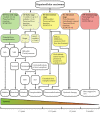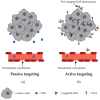Novel Nanotechnology Approaches to Overcome Drug Resistance in the Treatment of Hepatocellular Carcinoma: Glypican 3 as a Useful Target for Innovative Therapies
- PMID: 36077433
- PMCID: PMC9456072
- DOI: 10.3390/ijms231710038
Novel Nanotechnology Approaches to Overcome Drug Resistance in the Treatment of Hepatocellular Carcinoma: Glypican 3 as a Useful Target for Innovative Therapies
Abstract
Hepatocellular carcinoma (HCC) is the second most lethal tumor, with a 5-year survival rate of 18%. Early stage HCC is potentially treatable by therapies with curative intent, whereas chemoembolization/radioembolization and systemic therapies are the only therapeutic options for intermediate or advanced HCC. Drug resistance is a critical obstacle in the treatment of HCC that could be overcome by the use of targeted nanoparticle-based therapies directed towards specific tumor-associated antigens (TAAs) to improve drug delivery. Glypican 3 (GPC3) is a member of the glypican family, heparan sulfate proteoglycans bound to the cell surface via a glycosylphosphatidylinositol anchor. The high levels of GPC3 detected in HCC and the absence or very low levels in normal and non-malignant liver make GPC3 a promising TAA candidate for targeted nanoparticle-based therapies. The use of nanoparticles conjugated with anti-GPC3 agents may improve drug delivery, leading to a reduction in severe side effects caused by chemotherapy and increased drug release at the tumor site. In this review, we describe the main clinical features of HCC and the common treatment approaches. We propose the proteoglycan GPC3 as a useful TAA for targeted therapies. Finally, we describe nanotechnology approaches for anti-GPC3 drug delivery systems based on NPs for HCC treatment.
Keywords: drug delivery; glypican 3; hepatocellular carcinoma; nanomedicine; polymeric nanoparticles; targeted therapy.
Conflict of interest statement
The authors declare no conflict of interest in this publication.
Figures




Similar articles
-
Evaluation of antiglypican-3 therapy as a promising target for amelioration of hepatic tissue damage in hepatocellular carcinoma.Eur J Pharmacol. 2015 Jan 5;746:353-62. doi: 10.1016/j.ejphar.2014.11.008. Epub 2014 Nov 18. Eur J Pharmacol. 2015. PMID: 25449037
-
Glypican-3: A promising biomarker for hepatocellular carcinoma diagnosis and treatment.Med Res Rev. 2018 Mar;38(2):741-767. doi: 10.1002/med.21455. Epub 2017 Jun 16. Med Res Rev. 2018. PMID: 28621802 Review.
-
Cellular changes resulting from forced expression of glypican-3 in hepatocellular carcinoma cells.Mol Cells. 2006 Apr 30;21(2):224-8. Mol Cells. 2006. PMID: 16682817
-
Glypican-3: a marker and a therapeutic target in hepatocellular carcinoma.FEBS J. 2013 May;280(10):2471-6. doi: 10.1111/febs.12126. Epub 2013 Jan 31. FEBS J. 2013. PMID: 23305321 Review.
-
Development and in vitro study of a bi-specific magnetic resonance imaging molecular probe for hepatocellular carcinoma.World J Gastroenterol. 2019 Jun 28;25(24):3030-3043. doi: 10.3748/wjg.v25.i24.3030. World J Gastroenterol. 2019. PMID: 31293339 Free PMC article.
Cited by
-
Strategies and Recent Advances on Improving Efficient Antitumor of Lenvatinib Based on Nanoparticle Delivery System.Int J Nanomedicine. 2024 Jun 10;19:5581-5603. doi: 10.2147/IJN.S460844. eCollection 2024. Int J Nanomedicine. 2024. PMID: 38882543 Free PMC article. Review.
-
Advances in Immunotherapy and Innovative Therapeutic Approaches for Cancer Treatment: Editorial to the Special Issue "State-of-the-Art Molecular Oncology in Italy".Int J Mol Sci. 2023 May 18;24(10):8929. doi: 10.3390/ijms24108929. Int J Mol Sci. 2023. PMID: 37240286 Free PMC article.
-
Alpha-fetoprotein, glypican-3, and kininogen-1 as biomarkers for the diagnosis of hepatocellular carcinoma.Int J Clin Exp Pathol. 2024 Nov 15;17(11):383-395. doi: 10.62347/QSII4050. eCollection 2024. Int J Clin Exp Pathol. 2024. PMID: 39660335 Free PMC article. Review.
-
Ultrasound-Responsive Nanodelivery System of GPC3-Targeting and Sonosensitizer for Visualized Hepatocellular Carcinoma Therapy.Int J Nanomedicine. 2024 Jul 11;19:7015-7031. doi: 10.2147/IJN.S470847. eCollection 2024. Int J Nanomedicine. 2024. PMID: 39011387 Free PMC article.
-
Study on the Mechanism of Notch Pathway Mediates the Role of Lenvatinib-resistant Hepatocellular Carcinoma Based on Organoids.Curr Mol Med. 2025;25(3):343-352. doi: 10.2174/0115665240268201231213095302. Curr Mol Med. 2025. PMID: 38213137
References
Publication types
MeSH terms
Substances
Grants and funding
LinkOut - more resources
Full Text Sources
Medical

